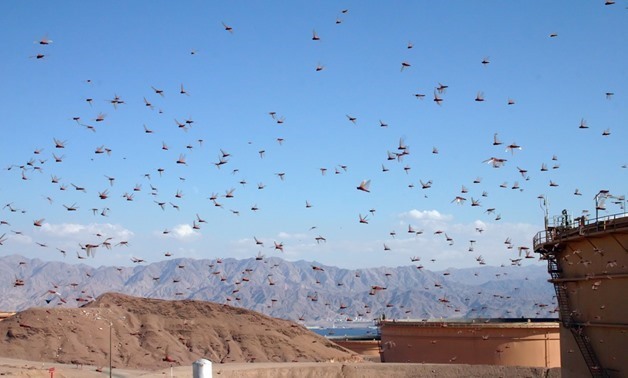
Swarms of locust in Eilat – Flickr/Niv Singer
CAIRO – 10 January 2020: Egypt’s Agriculture Ministry denied reports about alleged spread of locust swarms along the Egyptian borders, saying it has a comprehensive plan to confront any possible locust attack, the Cabinet media office reported.
The ministry affirmed declaring a maximum state of emergency as a precaution, and launching daily comprehensive operations in anticipation of any sudden attacks.
The agriculture ministry coordinated with relevant authorities to intensify its field exploration operations, the media office said in its report, saying that the ministry has obtained all equipment and pesticides required to counter locusts, in coordination with Food and Agriculture Organization (FAO) of the United Nations.
The ministry also has 55 bases nationwide to counter locusts, including 13 main bases.
Adult locust swarms can fly up to 150 km a day with the wind and adult insects can consume roughly their own weight in fresh food per day. A very small swarm eats as much in one day as about 35,000 people, posing a devastating threat to crops and food security.
Earlier attacks
In 1954, millions of red locusts attacked residential and agricultural areas, and destroyed all the crops in these areas. This was part of a regional attack that took place between 1954 and 1955, when 50 locust warms were recorded, destroying 250,000 tons of maize.
While in 1968, Egypt witnessed an attack from locust swarms coming from the Arabian Peninsula through the Red Sea,reportedly without causing any damage, as they did not manage to exceed the eastern desert areas of the country.
Many swarms of desert locusts later crossed the Atlantic Ocean from Mauritania and reached the Caribbean area, cutting more than 5,000 kilometers in 10 days in 1988. Around 68 swarms attacked the Egyptian territory. However, the attack did not exceed the mountainous and desert areas of the Egyptian border, as reported.
In 2004, Egypt experienced a sharp attack from the red locusts again where large swarms could invade Cairo, Beheira, Menoufia and Alexandria. The major attack however did not reportedly cause harm, because it was the type of active locusts that do not settle in one place for more than a night.
In 2007 and 2011, locust swarms attacked the Arabian Peninsula, while their remnants attacked Egypt, but could not cause any harm due to their small number. The attacking locusts were dealt with easily.
The last of these attacks was in 2013, where red locusts launched an attack across the southern border of the country and could access some Red Sea cities, in addition toHalayeb Triangle on the Egypt-Sudan border.

Comments
Leave a Comment